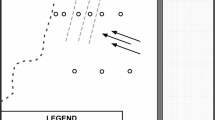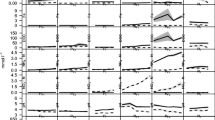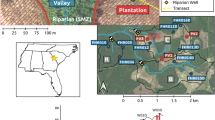Abstract
A mass balance procedure was used to determine rates of nitrate depletion in the riparian zone and stream channel of a small New Zealand headwater stream. In all 12 surveys the majority of nitrate loss (56–100%) occurred in riparian organic soils, despite these soils occupying only 12% of the stream's border. This disproportionate role of the organic soils in depleting nitrate was due to two factors. Firstly, they were located at the base of hollows and consequently a disproportionately high percentage (37–81%) of the groundwater flowed through them in its passage to the stream. Secondly, they were anoxic and high in both denitrifying enzyme concentration and available carbon. Direct estimates ofin situ denitrification rate for organic soils near the upslope edge (338 mg N m−2 h−1) were much higher than average values estimated for the organic soils as a whole (0.3–2.1 mg N m−2 h−1) and suggested that areas of these soils were limited in their denitrification activity by the supply of nitrate. The capacity of these soils to regulate nitrate flux was therefore under-utilized. The majority of stream channel nitrate depletion was apparently due to plant uptake, with estimates of thein situ denitrification rate of stream sediments being less than 15% of the stream channel nitrate depletion rate estimated by mass balance.
This study has shown that catchment hydrology can interact in a variety of ways with the biological processes responsible for nitrate depletion in riparian and stream ecosystems thereby having a strong influence on nitrate flux. This reinforces the view that those seeking to understand the functioning of these ecosystems need to consider hydrological phenomena.
Similar content being viewed by others
References
Anderson, M. G. & T. P. Burt, 1978. Toward more detailed field monitoring of variable source areas. Wat. Res. Res. 14: 1123–1131.
Burden, R. J., 1982. Nitrate contamination of New Zealand aquifers: a review. New Zealand J. Sci. 25: 205–220.
Burford, J. R. & J. M. Bremner, 1975. Relationship between the denitrification capacities of soils and total, water-soluble and readily decomposable soil organic matter. Soil Biol. Biochem. 7: 389–394.
Cooke, J. G., 1980. The effect of land use on water quality in New Zealand. In: Land use in Relation to Water Quantity and Quality. Nelson Catchment Board and Regional Water Board, Nelson: 40–60.
Cooke, J. G. & A. B. Cooper, 1988. Sources and sinks of nutrients in a New Zealand hill pasture catchment. III. Nitrogen. Hydrol. Processes 2: 135–149.
Cooke, J. G. & T. Dons, 1988. Sources and sinks of nutrients in a New Zealand hill pasture catchment. I. Stormflow generation. Hydrol. Processes 2: 109–122.
Cooke, J. G. & R. E. White, 1987. Spatial distribution of denitrifying activity in a stream draining an agricultural catchment. Freshwat. Biol. 18: 509–519.
Cooper, A. B. & J. G. Cooke, 1984. Nitrate loss and transformation in 2 vegetated headwater streams. New Zealand J. Mar. Freshwat. Res. 18: 441–450.
Downes, M. T., 1978. An improved hydrazine reduction method for the automated determination of low nitrate levels in fresh water. Wat. Res. 12: 673–676.
Dunne, T., 1978. Field studies of hillslope flow processes. In: M. J. Kirkby (ed.), Hillslope Hydrology. John Wiley & Sons, Chichester: 227–293.
Dunne, T., T. R. Moore & C. H. Taylor, 1975. Recognition and prediction of runoff-producing zones in humid regions. Hydrological Sciences-Bull. 20: 305–327.
Etchanchu, D. & J. L. Probst, 1988. Evolution of the chemical composition of the Garonne River water during the period 1971–1984. Hydrological Sciences J. 33: 243–256.
Focht, D. D., 1979. Microbial kinetics of nitrogen losses in flooded soils. In: N. C. Brady (ed.) Nitrogen and Rice. IRRI, Los Banos, Phillipines: 119–134.
Grimm, N. B., S. G. Fisher & W. L. Minckley, 1981. Nitrogen and phosphorus dynamics in hot desert streams of Southwestern USA. Hydrobiologia 93: 303–312.
Hagebro, C., S. Bang & E. Somer, 1983. Nitrate load/discharge relationships and nitrate load trends in Danish rivers. In Dissolved Loads of Rivers and Surface Water Quantity/Quality Relationships. IAHS Publ. No. 141: 377–386.
Hill, A. R., 1983. Denitrification: its importance in a river draining an intensively cropped watershed. Agric. Ecosyst. Envir. 10: 47–62.
Hill, A. R., 1988. Factors influencing nitrate depletion in a rural stream. Hydrobiologia 60: 111–122.
Hill, A. R. & K. Sanmugadas, 1985. Denitrification in relation to stream sediment characteristics. Wat. Res. 19: 1579–1586.
Hill, A. R. & N. Wylie, 1977. The influence of nitrogen fertilizers on stream nitrate concentrations near Alliston, Ontario, Canada. Prog. Wat. Technol. 8: 91–100.
Hoare, R. A., 1979. Nitrate removal from streams draining experimental catchments. Prog. Wat. Technol. 11: 303–314.
Hoglund, J. H., J. R. Crush, J. L. Brock, R. Ball & R. A. Carran, 1979. Nitrogen fixation in pasture. XII. General discussion. New Zealand J. Experimental Agric. 7: 45–41.
Howard-Williams, C., J. Davies & S. Pickmere, 1982. The dynamics of growth, the effects of changing area and nitrate uptake by watercress (Nasturtium officinale) in a New Zealand stream. J. Appl. Ecol. 19: 589–601.
Howard-Williams, C., S. Pickmere & J. Davies, 1983. Decay rates and nitrogen dynamics of decomposing watercress (Nasturtium officinale R. Br.). Hydrobiologia 99: 207–214.
Hynes, H. B. N., 1983. Groundwater and stream ecology. Hydrobiologia 100: 93–99.
Jacobs, T. C. & J. W. Gilliam, 1985. Riparian losses of nitrate from agricultural drainage waters. J. envir. Qual. 14: 472–478.
Kaspar, H. F. & J. M. Tiedje, 1980. Response of electron capture detector to hydrogen, oxygen, nitrogen, carbon dioxide, nitric oxide and nitrous oxide. J. Chromat. 193: 142–147.
Kaushik, N. K. & J. B. Robinson, 1976. Preliminary observations on nitrogen transport during summer in a small spring-fed Ontario stream. Hydrobiologia 49: 59–63.
Keeney, D. R. & D. W. Nelson, 1982. Nitrogen-Inorganic forms. In: A. L. Page (ed), Methods of Soil Analysis, Part 2. American Society of Agronomy-Soil Science Society of America, Madison: 643–498.
Lowrance, R. R., R. Leonard & J. Sheridan, 1985. Managing riparian ecosystems to control nonpoint pollution. J. Soil & Water Conservation 40: 87–91.
Lowrance, R. R., R. L. Todd & L. E. Asmussen, 1984(a). Nutrient cycling in an agricultural watershed: I. Phreatic movement. J. envir. Qual. 13: 22–27.
Lowrance, R. R., R. L. Todd & L. E. Asmussen, 1984(b). Nutrient cycling in an agricultural watershed: II. Streamflow and artificial drainage J. envir. Qual. 13: 27–32.
Neilsen, G. H., J. L. Culley & D. R. Cameron, 1980. Nonpoint N runoff from agricultural watersheds into the Great Lakes. J. Great Lakes Res. 6: 195–202.
Pionke, H. B., J. R. Hoover, R. R. Schnabel, W. J. Gburek, J. B. Urban & A. S. Rogowski, 1988. Chemical-hydrologic interactions in the near-stream zone. Wat. Resources Res. 24: 1101–1110.
Richardson, C. J. & J. A. Davis, 1987. Natural and artificial wetland ecosystems: ecological opportunities and limitations. In: K. R. Reddy & W. H. Smith (eds.), Aquatic Plants for Water Treatment and Resource Recovery. Magnolia Publishing, Orlando: 819–854.
Ritter, W. F., 1986. Water quality of agricultural Coastal Plain watersheds. Agric. Wastes 16: 201–216.
SAS, 1985. SAS users guide: statistics. SAS Insitute, Cary.
Smith, C. M., 1987. Sediment, phosphorus, and nitrogen in channelised surface run-off from a New Zealand pastoral catchment. New Zealand J. Mar. Freshwat. Res. 21: 627–639.
Smith, R. V., R. J. Stevens, R. H. Foy & C. E. Gibson, 1982. Upward trend in nitrate concentrations in rivers discharging into Lough Neagh for the period 1969–1979. Wat. Res. 16: 183–188.
Swank, W. T. & W. H. Caskey, 1982. Nitrate depletion in a second-order mountain stream. J. envir. Qual. 11: 581–584.
Terry, R. E. & R. L. Tate, 1980. Denitrification as a pathway for nitrate removal from organic soils. Soil Sci. 129: 162–166.
Tiedje, J. M., 1982. Denitrification. In A. L. Page (ed.), Methods of Soil Analysis, Part 2. American Society of Agronomy-Soil Science Society of America, Madison: 1011–1026.
Tiedje, J. M., A. J. Sexstone, D. D. Myrold & J. A. Robinson, 1982. Denitrification: ecological niches, competition and survival. Antonie van Leeuwenhoek 48: 569–583.
Toms, I. P., M. J. Mindenhall & M. M. I. Harman, 1975. Factors affecting the removal of nitrate by sediment from rivers, lagoons and lakes. Technical Report TR14. Wat. Res. Centre. Stevenage, Herts, England.
Triska, F. J., V. C. Kennedy & R. J. Avanzino, 1985. Uptake and regeneration of nitrate by epilithic communities in a nearly pristine lotic environment. Selected papers in the Hydrologic Sciences May 1985, USGS Water Supply Paper 2270: 91–98.
Webb, B. W. & D. E. Walling, 1985. Nitrate behaviour in streamflow from a grassland catchment in Devon, UK Wat. Res. 19: 1005–1016.
Wilcock, R. J., 1986. Agricultural run-off: a source of water pollution in New Zealand? New Zealand Agric. Sci. 20: 98–103.
Author information
Authors and Affiliations
Rights and permissions
About this article
Cite this article
Cooper, A.B. Nitrate depletion in the riparian zone and stream channel of a small headwater catchment. Hydrobiologia 202, 13–26 (1990). https://doi.org/10.1007/BF02208124
Received:
Revised:
Accepted:
Issue Date:
DOI: https://doi.org/10.1007/BF02208124




